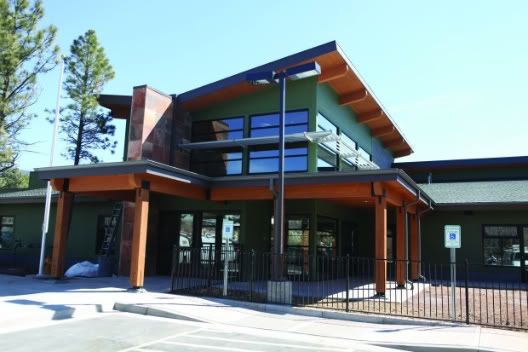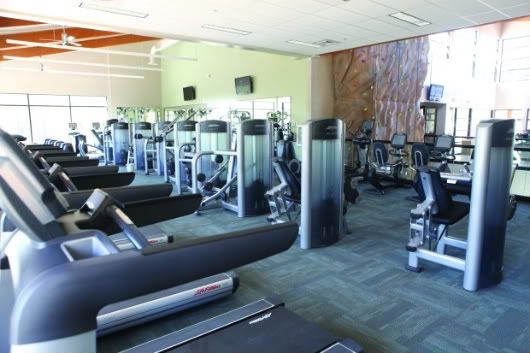The YMCA finally has its own home in Flagstaff--a brand new $6.2M, 20k s.f. facility in Switzer Canyon with a fitness center, full-sized basketball court, rock-climbing wall, snack bar and more:


The main entrance and one of the workout rooms at the Flagstaff Family YMCA.
(photos: Jake Bacon)
YMCA: Countdown to opening
by BETSEY BRUNER
Arizona Daily Sun
March 31, 2010
There are only a few loose ends left: Install lights in locker rooms; wait for snow to melt outside so playgrounds can be finished; and do a final clean-up and polish of all floors. Then it's swing-open-the-doors time as the Flagstaff Family YMCA invites the public into its new facilities during the official grand opening Saturday, April 17, at the 20,000-square-foot building on North Turquoise Drive in Switzer Canyon. The celebration will include speeches by officials, a brass quintet from the Flagstaff Symphony Orchestra, tours and special activities for children.
By any measure, the completed two-story facility is dazzling. Natural light flooded through east-facing windows during a press tour Tuesday morning. "Our lobby with its vaulted ceiling captures the setting sun," said Executive Director Paul Giguere, who has an upstairs office in the new building. "As you can tell, right now we don't even have our lights on."
The building features a 3,700-square-foot fitness center packed with new equipment, a gymnasium with a full-sized basketball court, group cycling room, rock climbing wall, snack bar, locker rooms with showers and an aerobics/group exercise studio, complete with a full-length wall mirror and ballet bar. Also housed in the building downstairs are preschool programs, complete with playgrounds, and the Northern Arizona College Resource Center, a free community service to middle and high school students interested in post-secondary schools.
THE 'WOW' FACTOR
Giguere (pronounced jig-air) came to town two years ago from Southern California to lead the Flagstaff Y, which is a branch of the Valley of the Sun YMCA. Sign-up for memberships began March 1, he said. "There's been a very positive response," Giguere said. "It's the 'Wow' factor. The two comments we're gotten so far are, 'Wow, I didn't know it was so big,' and ,'Wow, I didn't know there was so much fitness equipment.'" The staff of 20 will swell to 40 soon after the doors open, he said. "It's 18 days and counting," he said. "We're training our new staff -- the staff for the kids and the membership service staff. We're hiring and training personal trainers and fitness instructors."
It will take a bit more than a month to finalize the group fitness schedule, he added. "As membership grows, we'll be adding classes," Giguere said. Special pricing offers to charter members are available, the fee to join will be waived for anyone signing up through April 17. The Y is looking for 250 charter members, with a projected membership from 2,500 to 3,000 before a cap is reached. Nobody will be turned away from YMCA programs because of lack of money, he said, and scholarships are available for individuals and families in need.
YMCA WITHOUT WALLS
The YMCA presence here is not new. The organization began serving Flagstaff with the introduction of the YKidz Preschool, which opened in 1999 with seven children. Through the years, programs have been housed in many venues. The preschool met at Coconino Community College, swimming classes where at the Continental Country Club and the Holiday Inn and children's YMCA day camps were located at several FUSD schools.
"We've been a YMCA without walls for the past 11 years, so our programs have been throughout the community and all different schools," Giguere said. "The Y is focused on being rooted in its community." Despite having no home, the local YMCA has carved out a niche for itself. "The main draw is we're not a fitness club," Giguere explained. "We're a YMCA; we're really focused on the person and the family." All ages are welcome. "We even have single people who say they like seeing all the smiling kids doing activities and being involved," Giguere said. The facility will also be a community center, with opportunities for groups to have workshops, fund-raising events and even annual picnics in the building and on the grounds. "We're into being a multi-activity center," Giguere said.
KEEPING IT FLAGSTAFF
Giguere said the focus all along with the facility has been "keeping it really Flagstaff." The shape and size of the building was not dictated by some pre-determined norm. Creating a new home for the Flagstaff Family YMCA has been a labor of love. "This has been a project for the last 12 years, from the original founders who came together to put up the seed money to start the project -- Bob Senseman, APS and Bank of America," Giguere said. The first job of the committee the founders began was to gauge interest here. "The first thing they did was ask, 'Is this a town that would support a YMCA?" he said. "They spent the first three or four years looking into it." The answer to the question was "Yes."
A major fund-raising pushing in the last seven years brought in $5 million from the community, to complete the $6.2- million total needed to finish the building. After a groundbreaking in October 2008, construction has been nonstop, but a projected August 2009 opening was delayed by the changing financial market, Giguere said. Workers on the projects have also been local. "I'm excited personally; we went with a local architect, a local contractor and a local attorney," Giguere said. "I love it."
IF YOU GO...
WHAT: Flagstaff Family YMCA Grand Opening Celebration.
WHEN: Saturday, April 17, from 10 a.m. to 3 p.m.
WHERE: 1001 N. Turquoise Drive.
RSVP: Respond to invitation by April 13, Shannel Oliver at the Help Center, 556-9622.



